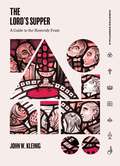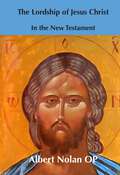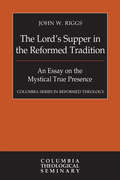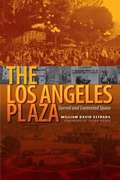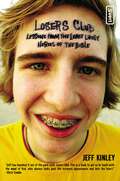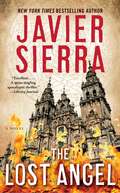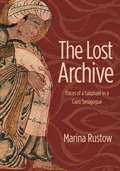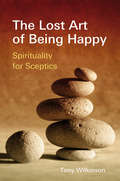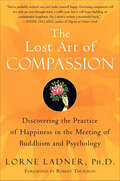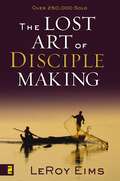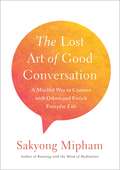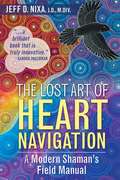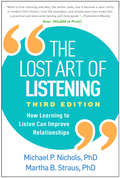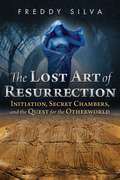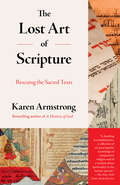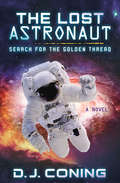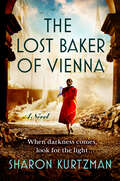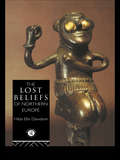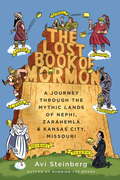- Table View
- List View
The Lord's Supper: A Guide to the Heavenly Feast (Christian Essentials)
by John W. KleinigYou receive Communion. But what does it mean? In The Lord's Supper: A Guide to the Heavenly Feast, John W. Kleinig awakens a hunger for meeting Jesus in the bread and wine. The Bible tells us that Jesus came from heaven to earth to give us himself, and his self-giving continues in the meal that he hosts. In the sacrament of Communion, Jesus offers believers nothing less than his holy, life-giving body and cleansing blood. He brings heaven to earth for us and gives us a foretaste of the heavenly supper of the Lamb. And by faith, we commune with him. In the Eucharist, Christians give thanks for God's gift of himself. "My soul will be satisfied as with the richest of foods." —Psalm 63:5
The Lord's Supper: Five Views
by Gordon T. SmithGordon Smith has invited five representatives of differing views within Christian tradition. Each holds his or her views with conviction and makes the case for that tradition. Each responds to the other views with charity, highlighting significant areas of agreement and disagreement.
The Lordship of Jesus Christ in the New Testament
by Albert NolanThis book is the first time that the 1963 Phd thesis by Albert Nolan OP from the Angelicum in Rome has been published. It deals with a title given to Christ that is problematic for many today. It is a title that is used many times in the New Testament and in the liturgy. When Albert initiated this research, he did so for academic purposes and to further his personal theological knowledge (faith seeking understanding) and spiritual growth. The term 'lord' is still very operative in the liturgy and prayer today. The lordship of Christ is a divine function, a saving function and it was given to Jesus by God. The divine functions are functions of ruling, saving, giving life and sending the Holy Spirit. The term lord is purposeful and meaningful divine service for the benefit of all God's People, the entire Church and for all of Creation, not to be equated with male-controlled interpretations and connotations of our current times. The clarification of the concept 'lord' for Jesus has undergone further clarifications since 1963, but the thesis now in book form, makes it clear that Albert was in search of theological clarification and understanding and he succeeded in his undertaking . . . Albert's findings make it clear that the title is not patriarchal, or sexist and neither exclusive. He underlines that the title 'lord' for Jesus Christ is a function and not a gender concern. The Lordship of Christ is a divine function, a saving function and it was given to Jesus by God. The divine functions are functions of ruling, saving, giving life and sending the Holy Spirit. it was given to Jesus to Jesus by God. The divine functions are functions of ruling, saving, giving life and sending the Holy Spirit.' From the Introduction by Jennifer Slater.
The Lord’s Prayer in the Early Church
by Roy HammerlingThe Lord s Prayer is arguably the most important prayer in Christianity. Still, exactly how the prayer developed in the life of the early church has remained hidden in ancient manuscripts. Hammerling s thorough and ground-breaking examination of these works reveals that early authors enthusiastically expounded upon its power and mystery, claiming that the prayer uttered by Christ belonged at the core of Christian ritual and beliefs. Many early church writers labeled it a "perfect summary of the gospel" and joyously referred to it as a pearl of great price and worth.
The Lord’s Supper in the Reformed Tradition
by John W. RiggsIn the Reformed tradition, the Lord's Supper is a sacrament that draws on a rich and deep tradition in its theology and practice. In this new volume in the Columbia Series in Reformed Theology, John Riggs provides a comprehensive overview of the most important Reformed theologians and confessions on the sacrament of the Lord's Supper. Riggs identifies the theology of true mystical union with Christ in the Supper as both a theological legacy the Reformed tradition inherited and a theological achievement that it refined. Ideal for studies in Reformed and liturgical theology, this is an important resource for investigating the eucharistic theology of the Reformed tradition.
The Los Angeles Plaza
by William David EstradaCity plazas worldwide are centers of cultural expression and artistic display. They are settings for everyday urban life where daily interactions, economic exchanges, and informal conversations occur, thereby creating a socially meaningful place at the core of a city. At the heart of historic Los Angeles, the Plaza represents a quintessential public space where real and imagined narratives overlap and provide as many questions as answers about the development of the city and what it means to be an Angeleno. The author, a social and cultural historian who specializes in nineteenth- and early twentieth-century Los Angeles, is well suited to explore the complex history and modern-day relevance of the Los Angeles Plaza. From its indigenous and colonial origins to the present day, Estrada explores the subject from an interdisciplinary and multiethnic perspective, delving into the pages of local newspapers, diaries and letters, and the personal memories of former and present Plaza residents, in order to examine the spatial and social dimensions of the Plaza over an extended period of time. The author contributes to the growing historiography of Los Angeles by providing a groundbreaking analysis of the original core of the city that covers a long span of time, space, and social relations. He examines the impact of change on the lives of ordinary people in a specific place, and how this change reflects the larger story of the city.
The Losers Club
by Jeff KinleyWe usually think of Bible characters as dressed with their Sunday best—lookin’ good, smelling of accomplishment, and holding the posture of unshakeable faith. We marvel at these “flawless saints” while thinking, “Wow! I’m not worthy!” Hey, not so fast. Believe it or not, the most celebrated people in the Bible were plagued by doubt, bad decisions, and less than perfect reputations. In a word, most were losers! And yet, God had plans that would take them beyond their humble, imperfect lives and dub them proud members of the “losers” club. Losers Club is a real-life look at famous Bible figures such as Moses, Solomon, David, Thomas, Rahab, and others. Each vignette reveals people who struggle with weak faith, confusion, and frustration—people very much like you and me! These stories will help you connect with these flawed heroes, find encouragement in their stories, and get inspired by God’s love and care for “losers.”
The Lost Angel
by Javier SierraNew York Times bestselling author Javier Sierra returns with a heartpounding, apocalyptic thriller about mankind's most ancient desire--and the modern evil some will unleash to obtain it. Every religion has a story for how our species came to mix with yours and was doomed to this planet. We are the sons of exiles. Cursed. Even man condemned us, blaming us for all the evils of the world. On the one hand you worshiped us, these beings who brought knowledge from the heavens. But you also feared us for what we might want in return. . . ." In approximately seventy-two hours, a little-known Middle Eastern terrorist group plans to bring about the end of the world. Convinced that they are the descendants of angels, they believe they are on the verge of at last being returned to heaven. Central to their plan is the kidnapping of Martin Faber, an undercover American scientist whose research has led him to an extraordinary secret. Martin's only hope for survival is his young wife, Julia Alvarez--a woman born with a rare psychic gift. But she must find the courage to save her husband, all while running from religious extremists and clandestine government agencies. Sierra takes readers on an adventure across the world, from the summit of Mount Ararat to the high desert of New Mexico, from the monuments of Washington, DC, to the medieval city of Santiago de Compostela in Spain. Sierra spent years investigating scientific and historical mysteries related to mankind's efforts to engage directly with the Almighty. The Lost Angel bears all the hallmarks of Sierra's erudite yet fast-paced brand of storytelling, combining historical fact and fiction with dazzling narrative feats.
The Lost Angel: A Novel
by Javier SierraNew York Times bestselling author Javier Sierra returns with a heartpounding, apocalyptic thriller about mankind's most ancient desire--and the modern evil some will unleash to obtain it. Every religion has a story for how our species came to mix with yours and was doomed to this planet. We are the sons of exiles. Cursed. Even man condemned us, blaming us for all the evils of the world. On the one hand you worshiped us, these beings who brought knowledge from the heavens. But you also feared us for what we might want in return. . . ." In approximately seventy-two hours, a little-known Middle Eastern terrorist group plans to bring about the end of the world. Convinced that they are the descendants of angels, they believe they are on the verge of at last being returned to heaven. Central to their plan is the kidnapping of Martin Faber, an undercover American scientist whose research has led him to an extraordinary secret. Martin's only hope for survival is his young wife, Julia Alvarez--a woman born with a rare psychic gift. But she must find the courage to save her husband, all while running from religious extremists and clandestine government agencies. Sierra takes readers on an adventure across the world, from the summit of Mount Ararat to the high desert of New Mexico, from the monuments of Washington, DC, to the medieval city of Santiago de Compostela in Spain. Sierra spent years investigating scientific and historical mysteries related to mankind's efforts to engage directly with the Almighty. The Lost Angel bears all the hallmarks of Sierra's erudite yet fast-paced brand of storytelling, combining historical fact and fiction with dazzling narrative feats.
The Lost Archive: Traces of a Caliphate in a Cairo Synagogue (Jews, Christians, and Muslims from the Ancient to the Modern World #63)
by Marina RustowA compelling look at the Fatimid caliphate's robust culture of documentationThe lost archive of the Fatimid caliphate (909–1171) survived in an unexpected place: the storage room, or geniza, of a synagogue in Cairo, recycled as scrap paper and deposited there by medieval Jews. Marina Rustow tells the story of this extraordinary find, inviting us to reconsider the longstanding but mistaken consensus that before 1500 the dynasties of the Islamic Middle East produced few documents, and preserved even fewer.Beginning with government documents before the Fatimids and paper’s westward spread across Asia, Rustow reveals a millennial tradition of state record keeping whose very continuities suggest the strength of Middle Eastern institutions, not their weakness. Tracing the complex routes by which Arabic documents made their way from Fatimid palace officials to Jewish scribes, the book provides a rare window onto a robust culture of documentation and archiving not only comparable to that of medieval Europe, but, in many cases, surpassing it. Above all, Rustow argues that the problem of archives in the medieval Middle East lies not with the region’s administrative culture, but with our failure to understand preindustrial documentary ecology.Illustrated with stunning examples from the Cairo Geniza, this compelling book advances our understanding of documents as physical artifacts, showing how the records of the Fatimid caliphate, once recovered, deciphered, and studied, can help change our thinking about the medieval Islamicate world and about premodern polities more broadly.
The Lost Ark of the Covenant: Solving the 2,500-Year-Old Mystery of the Fabled Biblical Ark
by Tudor ParfittAfter 2,500 Years of Mystery, the Truth About the Ark of the Covenant Is RevealedThe Lost Ark of the Covenant is the real-life account of an astounding quest—professor Tudor Parfitt's effort to recover the revered artifact that contained the Ten Commandments, sacred to Judaism, Christianity, and Islam. With painstaking historical scholarship, groundbreaking genetic science, and fascinating on-the-ground discoveries, Parfitt, who the Wall Street Journal calls "a British Indiana Jones," debunks the previous myths and reveals the shocking history of the Ark and its keepers.
The Lost Art of Being Happy
by Tony WilkinsonArguing that spirituality is not about religion but about living happily, this guidebook offers advice on the skills of the inner life-the mind and emotions-that are needed for a life of gladness. This examination discusses the requirements for happiness, explores their nature, and shows that mastering a set of five of them leads to bliss. The exercises in this resource are offered to spiritual seekers as a path towards happiness and emphasize that personal elation is not caused by external events, but by mastering the skills of the inner life.
The Lost Art of Compassion: Discovering the Practice of Happiness in the Meeting of Buddhism and Psychology
by Lorne LadnerA practical guide to cultivating compassion in those difficult moments of daily life: “Inspiring for all of us, therapists and patients alike.” —Mark Epstein, MD, author of Thoughts Without a ThinkerCompassion is often seen as a distant, altruistic ideal cultivated by saints, or as an unrealistic response of the naively kind-hearted. Seeing compassion in this way, we lose out on experiencing the transformative potential of one of our most neglected inner resources.Dr. Lorne Ladner rescues compassion from this marginalized, idealized place, showing how its practical application in our life can be a powerful force in achieving happiness. Combining the wisdom of Tibetan Buddhism and Western psychology, Ladner presents clear, effective practices for cultivating compassion in daily living.“[A] realistic, manageable approach to dispelling bitterness and anger and replacing it with empathy and patience.” —Publishers Weekly“You’ve probably noticed you can’t make yourself happy. Exercising compassion will not only get you through many a traffic jam . . . it will begin building an unshakeable happiness . . . a wonderful book.” —Annie Dillard, author of Pilgrim at Tinker CreekIncludes a foreword by Robert Thurman
The Lost Art of Disciple Making
by Leroy Eims Robert E. Coleman"Every believer in Jesus Christ deserves the opportunity of personal nurture and development." says LeRoy Eims. But all too often the opportunity isn't there. We neglect the young Christian in our whirl of programs, church services, and fellowship groups. And we neglect to raise up workers and leaders who can disciple young believers into mature and fruitful Christians. In simple, practical, and biblical terms, LeRoy Eims revives the lost art of disciple making. He explains: - How the early church discipled new Christians - How to meet the basic needs of a growing Christian - How to spot and train potential workers - How to develop mature, godly leaders "True growth takes time and tears and love and patience," Eims states. There is no instant maturity. This book examines the growth process in the life of a Christian and considers what nurture and guidance it takes to develop spiritually qualified workers in the church.
The Lost Art of Enochian Magic: Angels, Invocations, and the Secrets Revealed to Dr. John Dee
by Lon Milo Duquette John DesalvoA practical guide to Dr. John Dee’s angelic magic • Contains instructions for performing Enochian magic meditations • Examines John Dee’s original diaries from the British Library Enochian magic is a powerful, ancient system for opening portals to heavenly realms and enabling the ascent to God. The basis for many of the modern systems of magic, including the Golden Dawn, Enochian magic is named after the biblical prophet Enoch, who received the same knowledge and wisdom that was later conveyed to the astrologer to the court of Queen Elizabeth I, Dr. John Dee, by angels in the 16th century. In The Lost Art of Enochian Magic John DeSalvo traces the history of magic--from the earliest civilizations of the Akadians and Egyptians through the Greco-Roman period and up to the present time--to reveal how magic has penetrated and influenced our religious beliefs and practices today. Through his unprecedented investigation into the angelic magic of Dr. John Dee, during which time he deciphered Dee’s original phonetic notations in the margins of Dee’s 16th-century diaries, DeSalvo learned to properly reproduce the “Enochian calls,” which act like mantras in opening higher realms and invoking angels, key to this type of magical practice. DeSalvo shows how to use Enochian magic for personal spiritual development and also as protection from negative energies.
The Lost Art of Good Conversation: A Mindful Way to Connect with Others and Enrich Everyday Life
by Sakyong MiphamCutting through all the white noise, chatter, and superficiality our cell phones and social media cause, one of Tibet's highest and most respected spiritual leaders offers simple and practical advice to help us increase our attentions spans, become better listeners, and strive to appreciate the people around us.In a world of iPhones and connectivity to social media and email, we are all in constant connection with one another. Then why are so many people feeling burned out, distant from colleagues, and abandoned by family and friends? In this new book from the bestselling author of Running with the Mind of Meditation, the Sakyong uses the basic principles of the Shambhala tradition--meditation and a sincere belief in the inherent wisdom, compassion, and courage of all beings--to help readers to listen and speak more mindfully with loved ones, co-workers, strangers, and even ourselves. In this easy to understand and helpful book, Sakyong Mipham provides inspiring ideas and practical tips on how to be more present in your day-to-day life, helping us to communicate in ways that elevates the dignity of everyone involved. Great for families, employees and employers and everyone who spend too much time on Facebook, Instagram, and feel "disconnected" in our "connected" world, Good Conversation is a journey back to basics.
The Lost Art of Heart Navigation: A Modern Shaman’s Field Manual
by Jeff D. NixaDiscover your soul’s purpose by following the shamanic path of the heart • Explains how to engage your heart’s navigational guidance system to access your spiritual core directly and find your life purpose and spiritual identity • Includes shamanic practices to meet your power animals, consult with spirit guides, embark on journeys in the spirit world, slay your inner dragons of self-sabotage and fear, clear emotional wounding patterns, and find your personal spirit song • Offers case studies and troubleshooting help for common pitfalls and obstacles on the heart-centered shamanic path • Includes access to 4 guided audio journeys narrated by the author Each of us has a vision for our lives, our soul’s purpose awaiting release in our hearts. The most important task we have is to learn what that purpose is and then bring it into the world. In our world of endless busyness and “hurry sickness,” many people are experiencing soul loss as they live out dreams of endless motion, empty tasks, anxiety, and negative thoughts. But you can change your world and discover the shamanic heart path that activates your wildness, your power, and your soul’s purpose. Blending earth-honoring shamanic practices and modern depth psychology, Jeff Nixa explains how to practice the lost art of heart navigation to help you find your life purpose and spiritual identity, conquer the fear, doubt and criticism that stand in the way of that vision, and become a shamanic shapeshifter of your life. Providing heart-opening exercises to slow your mental racing and detect your heart’s navigational guidance system, he shows how to awaken your wild and free heart, access your spiritual core directly, deactivate trauma-based emotional patterns, retrieve vital energy, work with your dreams, and become an artist of the soul. You will learn how to meet your power animals and consult with spirit guides, embark on shamanic journeys in the spirit world for help and information, slay your inner dragons of self-sabotage, find your personal spirit song, and create the joyful life that your heart is attuned to seek out. Offering case studies and troubleshooting help for common pitfalls and obstacles on the heart-centered path, this shamanic manual provides hands-on practices and ceremonies--including access to 4 guided audio journeys narrated by the author--as well as wisdom from the author’s own journey and the powerful teachers he has worked with, including Sandra Ingerman, Mikkal, spiritual elders of the Oglala Lakota people, and plant-spirit medicine shamans of the Amazon jungle. Allowing you to understand the precise contours of your authentic self and your visionary heart, this book offers a map to a vibrant new life aligned with your soul and deepest calling.
The Lost Art of Listening, Third Edition: How Learning to Listen Can Improve Relationships (Guilford Family Therapy Ser.)
by Michael P. Nichols Martha B. Straus"That isn't what I meant!" Truly listening and being heard is far from simple, even between people who care about each other. This perennial bestseller--now revised and updated for the digital age--analyzes how any conversation can go off the rails and provides essential skills for building mutual understanding. Thoughtful, witty, and empathic, the book is filled with vivid stories of couples, coworkers, friends, and family working through tough emotions and navigating differences of all kinds. Learn ways you can: *Hear what people mean, not just what they say. *Share a difference of opinion without sounding dismissive. *Encourage uncommunicative people to open up. *Make sure both sides get heard in heated discussions. *Get through to someone who never seems to listen. *Ask for support without getting unwanted advice. *Reduce miscommunication in texts and online. From renowned therapist Michael P. Nichols and new coauthor Martha B. Straus, the third edition reflects the huge impact of technology and social media on relationships, and gives advice for talking to loved ones across social and political divides
The Lost Art of Resurrection: Initiation, Secret Chambers, and the Quest for the Otherworld
by Freddy SilvaReveals the radical ancient practice of living resurrection, in which initiates ritually died and were reborn into a state of higher consciousness • Explores living resurrection initiation practices from world cultures, including Egyptian, Greek, Gnostic, Chinese, Celtic, and Native American traditions • Describes the secret chambers and temples where Mystery Schools practiced “raising the dead” • Shows why this practice was branded a heresy and suppressed by the Church More than two thousand years before the resurrection of Jesus, initiates from spiritual traditions around the world were already practicing a secret mystical ritual in which they metaphorically died and were reborn into a higher spiritual state. During this living resurrection, they experienced a transformative spiritual awakening that revealed the nature of reality and the purpose of the soul, described as “rising from the dead.” Exploring the practice of living resurrection in ancient Egyptian, Phoenician, Greek, Persian, Indian, Japanese, Chinese, Celtic, and Native American traditions, Freddy Silva explains how resurrection was never meant for the dead, but for the living--a fact supported by the suppressed Gnostic Gospel of Philip: “Those who say they will die first and then rise are in error. If they do not first receive the resurrection while they live, when they die they will receive nothing.” He reveals how these practices were not only common in the ancient world but also shared similar facets in each tradition: initiates were led through a series of challenging ordeals, retreated for a three-day period into a cave or restricted room, often called a “bridal chamber,” and while out-of-body, became fully conscious of travels in the Otherworld. Upon returning to the body, they were led by priests or priestesses to witness the rising of Sirius or the Equinox sunrise. Silva describes some of the secret chambers around the world where the ritual was performed, including the so-called tomb of Thutmosis III in Egypt, which featured an empty sarcophagus and detailed instructions for the living on how to enter the Otherworld and return alive. He reveals why esoteric and Gnostic sects claimed that the literal resurrection of Jesus promoted by the Church was a fraud and how the Church branded all living resurrection practices as a heresy, relentlessly persecuting the Gnostics to suppress knowledge of this self-empowering experience. He shows how the Knights Templar revived these concepts and how they survive to this day within Freemasonry. Exploring the hidden art of living resurrection, Silva shows how this personal experience of the Divine opened the path to self-empowerment and higher consciousness, leading initiates such as Plato to describe it as the pinnacle of spiritual development.
The Lost Art of Scripture: Rescuing the Sacred Texts
by Karen ArmstrongIn this timely and important book, one of the world's leading commentators on religious affairs examines the lost art of Scripture as a medium to lift humanity and change our perception of reality while evading logical explanation. Today the Quran is used by some to justify war and acts of terrorism, the Torah to deny Palestinians the right to live in the Land of Israel, and the Bible to condemn homosexuality and contraception. The significance of Scripture--the holy texts at the centre of all religious traditions--may not be immediately obvious in our secular world but its misunderstanding is perhaps the root cause of most of today's controversies over religion. In this timely and important book, one of the world's leading commentators on religious affairs examines the meaning of Scripture. Today holy texts are not only used selectively to underwrite sometimes arbitrary and subjective views: they are seen to prescribe ethical norms and codes of behaviour that are divinely ordained--they are believed to contain eternal truths. But as Karen Armstrong shows in this fascinating trawl through millennia of religious history, this peculiar reading of Scripture is a relatively recent, modern phenomenon--and in many ways, a reaction to a hostile secular world. For most of their history, the world's religious traditions have regarded these texts as tools for the individual to connect with the divine, to transcend their physical existence, and to experience a higher level of consciousness that helped them to engage with the world in more meaningful and compassionate ways. Scripture was not a "truth" that had to be "believed." Armstrong argues that only if the world's religious faiths rediscover such an open and spiritual engagement with their holy texts can they curtail the arrogance, intolerance and violence that flows from a narrow reading of Scripture as truth.
The Lost Art of Scripture: Rescuing the Sacred Texts
by Karen ArmstrongA book that shines fresh light on the world's major religions to help us build bridges between faiths and rediscover a creative and spiritual engagement with holy texts—from the New York Times bestselling author of A History of God&“[An] unusual, often dazzling, blend of theology, history, and neuroscience&” —The New YorkerThe significance of scripture may not be immediately obvious in our secular world, but its misunderstanding is perhaps the root cause of many of today's controversies. The sacred texts have been co-opted by fundamentalists, who insist that they must be taken literally, and by others who interpret scripture to bolster their own prejudices. These texts are seen to prescribe ethical norms and codes of behavior that are divinely ordained: they are believed to contain eternal truths. But as Karen Armstrong shows in this chronicle of the development and significance of major religions, such a narrow, peculiar reading of scripture is a relatively recent, modern phenomenon. For most of their history, the world's religious traditions have regarded these texts as tools that enable the individual to connect with the divine, to experience a different level of consciousness, and to help them engage with the world in more meaningful and compassionate ways.
The Lost Astronaut: A Novel
by D. J. ConingA space traveler lives out his recurring nightmare foretelling the impending destruction of Earth—and the horrific fate of humankind. Raised by his grandparents on a Midwestern farm, Jag is selected as one of twelve prodigy students enrolled in the first-ever Space University on board the International Space Station. There he competes against fellow classmates to create an invention that will propel humanity into intergalactic travel. Overcome with jealousy, a fellow classmate sabotages Jag&’s creation and sends him spiraling into deep space, where he is enslaved by ruthless pirates, sent to prison for a crime he didn&’t commit, and put in a position where he ultimately holds the salvation of Earth in his hands. Can Jag overcome his bitterness and forgive those who harmed him in time to save humanity?
The Lost Baker of Vienna: A Novel
by Sharon KurtzmanAn historical novel inspired by the experiences of the author&’s own family after the Holocaust, a sweeping saga about survival, loss, love, and the reverberating effects of warIn 2018, Zoe Rosenzweig is reeling after the loss of her beloved grandfather, a Holocaust survivor. She becomes obsessed with finding out what really happened to her family during the war.Vienna, 1946: Chana Rosenzweig has endured the horrors of war to find herself, her mother, and her younger brother finally free in Vienna. But freedom doesn&’t look like they&’d imagined it would, as they struggle to make a living and stay safe.Despite the danger, Chana sneaks out most nights to return to the hotel kitchen where she works as a dishwasher, using the quiet nighttime hours to bake her late father&’s recipes. Soon, Chana finds herself caught in a dangerous love triangle, torn between the black-market dealer who has offered marriage and protection, and the apprentice baker who shares her passions. How will Chana balance her love of baking against her family&’s need for security? The Lost Baker of Vienna affirms the unbreakable bonds of family, shining a light on the courageous spirit of WWII refugees as they battle to survive the overwhelming hardships of a world torn apart.
The Lost Beliefs of Northern Europe
by Dr Hilda Davidson Hilda Ellis DavidsonFragments of ancient belief mingle with folklore and Christian dogma until the original tenets are lost in the myths and psychologies of the intervening years. Hilda Ellis Davidson illustrates how pagan beliefs have been represented and misinterpreted by the Christian tradition, and throws light on the nature of pre-Christian beliefs and how they have been preserved. The Lost Beliefs of Northern Europe stresses both the possibilities and the difficulties of investigating the lost religious beliefs of Northern Europe.
The Lost Book of Mormon
by Avi SteinbergIs the Book of Mormon the Great American Novel? Decades before Melville and Twain composed their great works, a farmhand and child seer named Joseph Smith unearthed a long-buried book from a haunted hill in western New York State that told of an epic history of ancient America, a story about a family that fled biblical Jerusalem and took a boat to the New World. Using his prophetic gift, Joseph translated the mysterious book into English and published it under the title The Book of Mormon. The book caused an immediate sensation, sparking anger and violence, boycotts and jealousy, curiosity and wonder, and launched Joseph on a wild, decades-long adventure across the American West. Today The Book of Mormon, one of the most widely circulating works of American literature, continues to cause controversy--which is why most of us know very little about the story it tells. Avi Steinberg wants to change that. A fascinated nonbeliever, Steinberg spent a year and a half on a personal quest, traveling the path laid out by Joseph's epic. Starting in Jerusalem, where The Book of Mormon opens with a bloody murder, Steinberg continued to the ruined Maya cities of Central America--the setting for most of the The Book of Mormon's ancient story--where he gallivanted with a boisterous bus tour of believers exploring Maya archaeological sites for evidence. From there the journey took him to upstate New York, where he participated in the true Book of Mormon musical, the annual Hill Cumorah Pageant. And finally Steinberg arrived at the center of the American continent, Jackson County, Missouri, the spot Smith identified as none other than the site of the Garden of Eden.Threaded through this quirky travelogue is an argument for taking The Book of Mormon seriously as a work of American imagination. Literate and funny, personal and provocative, the genre-bending The Lost Book of Mormon boldly explores our deeply human impulse to write bibles and discovers the abiding power of story.From the Hardcover edition. about us. And also an answer to the question: Why are we so afraid of the Book of Mormon? Literate and funny, personal and provocative, the genre-bending Lost Book of Mormon boldly explores our deeply human impulse to write bibles and discovers the abiding power of story.
